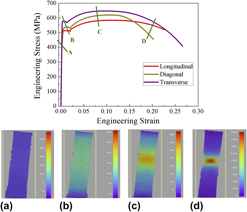Article contents
Anisotropy and microstructural evolutions of X70 pipeline steel during tensile deformation
Published online by Cambridge University Press: 26 June 2018
Abstract

Tensile properties of different directions of X70 pipeline steel plate were tested, and microstructural evolutions of different zones along the transverse direction (TD) were also investigated using electron backscatter diffraction. The highest strength values (yield strength and ultimate strength) appear at TD, and the diagonal direction shows the largest uniform elongation. The elongations of the polygonal ferrite and quasi polygonal ferrite grains increase with the decrease in the distance to the fracture zone. The ratio between high-angle grain boundaries and low-angle grain boundaries in the as-received steel is about 7/3 and starts to decrease from the fillet zone to the fracture zone. The refinement of grains occurs adjacent to the fracture section with the formation of subgrains. With the increase in tensile strain, the intensities of cube and γ-fiber textures increase sharply, and the reinforcement of the (111) $\left[ {\bar{1}\bar{1}2} \right]$ component was obviously larger than the (111)
$\left[ {\bar{1}\bar{1}2} \right]$ component was obviously larger than the (111) $\left[ {1\bar{2}1} \right]$ component in the γ-fiber texture during tensile deformation.
$\left[ {1\bar{2}1} \right]$ component in the γ-fiber texture during tensile deformation.
- Type
- Article
- Information
- Copyright
- Copyright © Materials Research Society 2018
References
REFERENCES
- 8
- Cited by




